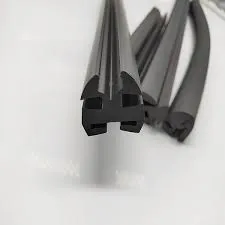CE Certification for Flexible Door and Window Seal Strips Quality Standards and Compliance
Nov . 08, 2024 10:26 Back to list
CE Certification for Flexible Door and Window Seal Strips Quality Standards and Compliance
Understanding CE Certification for Door and Window Seal Strips
In the realm of construction and manufacturing, safety and quality are paramount. One of the essential components in ensuring both energy efficiency and security in buildings is the use of door and window seal strips. These components play a critical role in preventing drafts, reducing noise, and enhancing the overall comfort of indoor environments. However, not all seal strips are created equal; this is where CE certification comes into play.
What is CE Certification?
CE certification indicates that a product meets European Union (EU) safety, health, and environmental protection standards. The CE mark stands for Conformité Européenne, which translates to European Conformity. Products bearing this mark are deemed compliant with EU directives, which helps facilitate trade within the European Economic Area (EEA).
For manufacturers of door and window seal strips, obtaining CE certification is a vital step. It signifies that their products meet stringent regulatory requirements and are safe for consumer use. This certification is particularly relevant in the construction industry, as it assures builders and contractors that the materials they are using will perform effectively and adhere to rigorous safety standards.
The Importance of Door and Window Seal Strips
Door and window seal strips are often overlooked despite their crucial role in buildings. These strips create airtight seals, preventing air leaks that can lead to higher energy costs due to heating and cooling inefficiencies. Furthermore, they reduce outdoor noise pollution, enhance indoor air quality, and provide protection against pests and moisture infiltration.
In addition to improving energy efficiency, seal strips contribute to a building's overall durability and longevity. By preventing drafts and moisture accumulation, these components help mitigate issues such as mold growth and structural damage. Consequently, investing in high-quality seal strips is essential for homeowners, builders, and architects alike.
How CE Certification Benefits Consumers
For consumers, choosing CE-certified seal strips offers numerous advantages
1. Assurance of Quality The CE mark confirms that the product has been rigorously tested and complies with EU regulations, ensuring that it meets high standards of quality and performance.
2. Enhanced Safety CE-certified products are evaluated for their safety features, reducing the risk of accidents associated with faulty materials.
ce cetification door window seal strip

3. Environmental Compliance Many consumers today are environmentally conscious. CE certification indicates that products have been assessed for their environmental impact, aligning with sustainable building practices.
5. Marketability For manufacturers, having CE certification can enhance brand reputation and expand market opportunities, particularly within the European market where compliance is mandated.
The Process of Obtaining CE Certification
The process of obtaining CE certification involves several key steps
1. Identifying Relevant Directives Manufacturers must identify which EU directives apply to their product, particularly the Construction Products Regulation (CPR) for building materials like seal strips.
2. Product Testing The product must undergo testing to verify compliance with relevant standards. This may be conducted by either the manufacturer or a recognized third-party testing facility.
3. Documentation Manufacturers must compile a technical file that includes test results, product specifications, and information on how the product complies with regulatory requirements.
4. Declaration of Conformity Once testing and documentation are complete, manufacturers must prepare a Declaration of Conformity, which states that the product meets EU standards.
5. Affixing the CE Mark Finally, once the product is deemed compliant, the CE mark can be affixed to the product, allowing it to be sold within the EEA.
Conclusion
CE certification for door and window seal strips is more than just a regulatory requirement; it is a crucial component of ensuring product quality, safety, and environmental responsibility. For consumers, builders, and manufacturers alike, understanding and embracing CE certification can lead to more informed choices, enhanced safety, and better overall performance of building materials. Investing in CE-certified seal strips ultimately contributes to more sustainable, efficient, and comfortable living spaces, making it an essential aspect of modern construction practices.
-
Top Window Seal Strip Adhesive Companies for Quality Sealing Solutions
NewsJul.22,2025
-
HighTech Injection LED Module Size 6414 - Efficient, Durable Lighting
NewsJul.22,2025
-
Top Window Seal Strip Adhesive Companies | Durable Weatherproof Seals
NewsJul.21,2025
-
Premium Car Trim Strip - Top Car Moulding Trim Strip Exporters & 3 Car Moldings Manufacturers
NewsJul.08,2025
-
High-Quality Sponge Seal Solutions Leading Sponge Door Seal Manufacturer & Service
NewsJul.08,2025
-
U Shape Chrome Trim Strip Manufacturer & Exporter High-Quality Factory Products
NewsJul.07,2025
